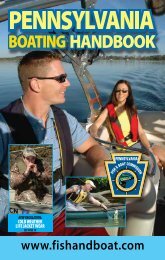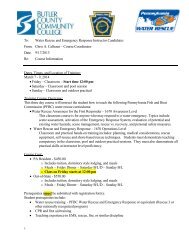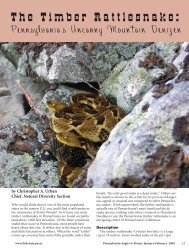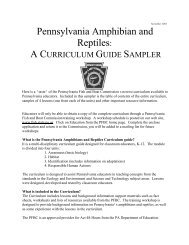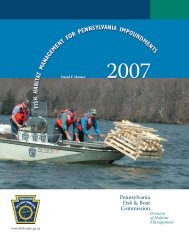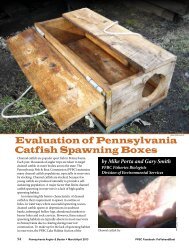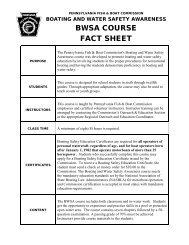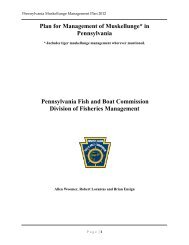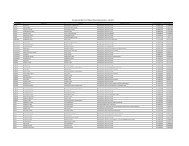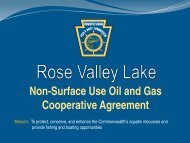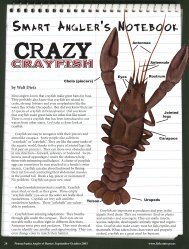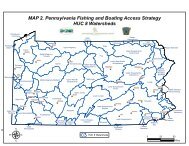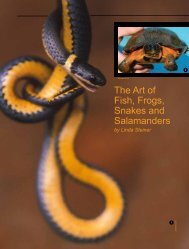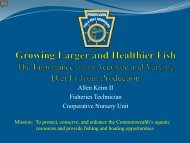Lehigh River Water Trail – Northern Section - Pennsylvania Fish and ...
Lehigh River Water Trail – Northern Section - Pennsylvania Fish and ...
Lehigh River Water Trail – Northern Section - Pennsylvania Fish and ...
Create successful ePaper yourself
Turn your PDF publications into a flip-book with our unique Google optimized e-Paper software.
<strong>Lehigh</strong> <strong>River</strong> <strong>Water</strong> <strong>Trail</strong> <strong>–</strong> <strong>Northern</strong> <strong>Section</strong><br />
Map & Guide<br />
<strong>Water</strong> trails are recreational waterways on a lake, river, or ocean between specific points, containing access points <strong>and</strong> day-use <strong>and</strong>/or camping sites for the boating<br />
public. <strong>Water</strong> trails emphasize low-impact use <strong>and</strong> promote stewardship of the resources. Explore this unique <strong>Pennsylvania</strong> water trail.<br />
For your safety <strong>and</strong> enjoyment:<br />
• Always wear a life jacket.<br />
• Obtain proper instruction in boating skills.<br />
• Know fishing <strong>and</strong> boating regulations.<br />
• Be prepared for river hazards.<br />
• Carry proper equipment.<br />
A PENNSYLVANIA SCENIC RIVER THE LEHIGH RIVER<br />
In 1982, a 32-mile section in the upper section <strong>Lehigh</strong> <strong>River</strong><br />
corridor was designated a <strong>Pennsylvania</strong> Scenic <strong>River</strong>. This special<br />
designation is intended to help preserve the primitive qualities, as well<br />
as the natural <strong>and</strong> aesthetic values, of our rivers <strong>and</strong> adjacent l<strong>and</strong><br />
environment. <strong>River</strong>s so designated shall be free-flowing <strong>and</strong> capable<br />
of supporting both aquatic life, as well as water-based recreation.<br />
THE LEHIGH RIVER WATER TRAIL<br />
The <strong>Lehigh</strong> <strong>River</strong> <strong>Water</strong> <strong>Trail</strong> is 72-miles long, starting at White<br />
Haven <strong>and</strong> ending in the city of Easton at the <strong>Lehigh</strong> <strong>River</strong>’s<br />
confluence with the Delaware <strong>River</strong>. There the traveler can continue<br />
down the Delaware towards Philadelphia <strong>and</strong> beyond to Delaware<br />
Bay.<br />
<strong>Northern</strong> <strong>Section</strong><br />
This 41-mile segment of the <strong>Lehigh</strong> <strong>River</strong> <strong>Water</strong> <strong>Trail</strong> begins at<br />
White Haven at an access to the <strong>Lehigh</strong> Gorge State Park <strong>and</strong> ends at<br />
the <strong>Lehigh</strong> Gap at Blue Mountain at the Carbon-<strong>Lehigh</strong>-Northampton<br />
county line. Deep gorges <strong>and</strong> fast-moving water characterize this<br />
section of the <strong>Water</strong> <strong>Trail</strong>. Substantial canoeing or kayaking<br />
experience is required to maneuver most sections this reach of the<br />
river. It contains several access points <strong>and</strong> traverses 26 miles of the<br />
<strong>Lehigh</strong> Gorge State Park.<br />
Southern <strong>Section</strong><br />
This 31-mile segment of the <strong>Water</strong> <strong>Trail</strong> begins at the <strong>Lehigh</strong> Gap<br />
at Blue Mountain at the Carbon-<strong>Lehigh</strong>-Northampton county line <strong>and</strong><br />
ends at the confluence of the <strong>Lehigh</strong> <strong>River</strong> with the Delaware <strong>River</strong> in<br />
the city of Easton. This reach of the <strong>Water</strong> <strong>Trail</strong> widens out <strong>and</strong> tends<br />
to become more leisurely than the northern section. The l<strong>and</strong> around<br />
the river is characterized by rolling hills <strong>and</strong> forested riparian<br />
corridors. The river contains numerous access points <strong>and</strong> passes<br />
through the urban centers of Allentown, Bethlehem, <strong>and</strong> Easton.<br />
Located in northeastern <strong>Pennsylvania</strong>, the <strong>Lehigh</strong> <strong>River</strong> originates<br />
in a series of glacial bogs <strong>and</strong> marshes in the area of Pocono Peak<br />
Lake in the Gouldsboro area about 15 miles southeast of Scranton.<br />
The elevation at the <strong>Lehigh</strong> <strong>River</strong> headwaters is approximately 2,200<br />
feet above sea level, <strong>and</strong> drops nearly 1,000 feet during its 103-mile<br />
journey to its confluence with the Delaware <strong>River</strong> in Easton. The<br />
<strong>Lehigh</strong>’s watershed is approximately 1,345 square-miles in area <strong>and</strong><br />
consists of approximately 2,000 miles of streamways. It is a<br />
significant sub-basin within the Delaware <strong>River</strong> watershed.<br />
The <strong>Lehigh</strong> <strong>River</strong> forms the geopolitical boundary between many<br />
of the ten counties within its watershed. The river flows through<br />
Wayne, Lackawanna, Luzerne, Monroe, Carbon, <strong>Lehigh</strong>, <strong>and</strong><br />
Northampton counties. The largest cities <strong>–</strong> Allentown, Bethlehem,<br />
<strong>and</strong> Easton <strong>–</strong> are found on the banks of the <strong>Lehigh</strong> in the river’s lower<br />
reaches. There are many smaller historic hamlets <strong>and</strong> villages<br />
sprinkled from top to bottom. The river is impounded in several<br />
places by dams the most significant of which is the Francis E. Walter<br />
Dam in Luzerne <strong>and</strong> Carbon counties.<br />
At White Haven, the <strong>Lehigh</strong> <strong>River</strong> <strong>and</strong> its banks become part of<br />
<strong>Lehigh</strong> Gorge State Park. Over the next 32 miles, the river flows<br />
through a wilderness area <strong>and</strong> official <strong>Pennsylvania</strong> Scenic <strong>River</strong><br />
section that is a mecca for whitewater boaters <strong>and</strong> mountain bikers.<br />
Near the town of Jim Thorpe <strong>and</strong> on into Bowmanstown, the river is<br />
characterized by calmer water <strong>and</strong> is widely enjoyed by kayakers,<br />
rafters, <strong>and</strong> canoeists.<br />
At the Carbon-<strong>Lehigh</strong>-Northampton county line, the river<br />
makes a dramatic cut through the Blue Mountain. Called <strong>Lehigh</strong> Gap,<br />
it separates the upper portion of the watershed from the two-county<br />
“<strong>Lehigh</strong> Valley,” as <strong>Lehigh</strong> <strong>and</strong> Northampton counties are called. The<br />
<strong>Lehigh</strong> <strong>River</strong> continues south past the historic towns of Walnutport,<br />
Slatington, Catasauqua, <strong>and</strong> Allentown where South Mountain<br />
deflects the <strong>Lehigh</strong> <strong>River</strong>’s southward flow sharply to the east towards<br />
Bethlehem. At Bethlehem, the <strong>Lehigh</strong> <strong>River</strong>’s speed continues to<br />
slow until it merges with the Delaware <strong>River</strong> after the dam in Easton.<br />
RESPECT THE PRIVACY & RIGHTS OF LANDOWNERS FISHING OPPORTUNITIES<br />
Please respect the privacy <strong>and</strong> rights of l<strong>and</strong>owners along the<br />
Juniata <strong>River</strong> <strong>Water</strong> <strong>Trail</strong> by obtaining permission before entering any<br />
privately owned l<strong>and</strong>. Unless you are otherwise certain, assume the<br />
l<strong>and</strong> is private property. In any case, avoid loud noises <strong>and</strong> boisterous<br />
behavior. Remember that sound carries across water much more<br />
clearly than on l<strong>and</strong>. Some of the l<strong>and</strong>owners enjoy the peace <strong>and</strong><br />
solitude overlooking the river from their back yards. Use the same<br />
courtesy that you would want. A friendly wave or quiet greeting is<br />
always welcome.<br />
Help care for the l<strong>and</strong>, water <strong>and</strong> cultural resources along the<br />
Juniata <strong>River</strong> by respecting wildlife, nature <strong>and</strong> other recreationists. It<br />
is important to wash footwear, boats, <strong>and</strong> vehicles to minimize the<br />
spread of invasive species from one place to another. “Leave No<br />
Trace,” a national outdoor ethics program, provides some guidelines<br />
to minimize your impact. For more information about “Leave No<br />
Trace” outdoor ethics, visit www.Lnt.org.<br />
STEWARDSHIP<br />
The <strong>Lehigh</strong> <strong>River</strong> supports a diverse fishery that includes<br />
trout, smallmouth bass, muskellunge, catfish, <strong>and</strong> American<br />
shad. The river is stocked with trout from White Haven to Jim<br />
Thorpe by the <strong>Pennsylvania</strong> <strong>Fish</strong> <strong>and</strong> Boat Commission <strong>and</strong> by<br />
several local sport-fishing groups from Jim Thorpe to Allentown.<br />
Check the current fishing regulations <strong>and</strong> seasons before<br />
fishing the river. Review this year’s fishing summary online at:<br />
www.fish.state.pa.us.<br />
Leave no trace for camping <strong>and</strong> day use:<br />
1. Plan <strong>and</strong> prepare.<br />
2. Travel <strong>and</strong> camp on durable surfaces.<br />
3. Dispose of waste properly.<br />
4. Leave what you find.<br />
5. Minimize campfires.<br />
6. Respect wildlife.<br />
7. Be considerate of other visitors.
• Wear your life jacket. Some 80 percent of all recreational<br />
boating fatalities happen to people who are not wearing a life<br />
jacket.<br />
• Expect to get wet. Even the best paddlers sometimes capsize or<br />
swamp their boats. Bring extra clothing in a waterproof bag.<br />
• Be prepared to swim. If the water looks too hazardous to swim<br />
in, don’t go paddling.<br />
• If you capsize, hold on to your boat, unless it presents a lifethreatening<br />
situation. If floating in current, position yourself on<br />
the upstream side of the capsized boat.<br />
• Scout ahead whenever possible. Know the river. Avoid<br />
surprises.<br />
• Be prepared for the weather. Get a forecast before you go.<br />
Sudden winds <strong>and</strong> rain are common <strong>and</strong> can turn a pleasant trip<br />
into a risky, unpleasant venture.<br />
• One wearable, Coast Guard-approved personal flotation device (PFD<br />
or life jacket) in serviceable condition <strong>and</strong> of the appropriate sizeis<br />
required for each person in your boat. If your boat is 16 feet or<br />
longer, one throwable device (seat cushion or ring buoy) is required.<br />
Canoes <strong>and</strong> kayaks, regardless of length, are not required to carry a<br />
throwable device.<br />
• Life jackets must be worn by all children 12 years old <strong>and</strong> younger<br />
on all boats 20 feet or less in length while under way, <strong>and</strong> on all<br />
canoes <strong>and</strong> kayaks. Others are strongly encouraged to wear a PFD at<br />
all times on the water.<br />
• All boats must display an anchor light (a white light visible 360<br />
degrees) when at anchor between sunset <strong>and</strong> sunrise. Boats can use a<br />
lantern or clip-on battery-powered unit to meet this requirement.<br />
• All powered boats must show running lights between sunset <strong>and</strong><br />
sunrise. Between sunset <strong>and</strong> sunrise, unpowered boats must carry a<br />
white light (visible 360 degrees), installed or portable, ready to be<br />
displayed in time to avoid a collision.<br />
The size of the <strong>Lehigh</strong> <strong>River</strong> <strong>and</strong> the releases from the Francis E.<br />
Walter Dam make the river navigable in some way most days of the<br />
year. There are exceptions, however, particularly in the northern<br />
section of the <strong>Water</strong> <strong>Trail</strong> (above the <strong>Lehigh</strong> Gap), which should be<br />
monitored carefully in conditions of high flow. The northern section<br />
of the <strong>Water</strong> <strong>Trail</strong> where it passes through the <strong>Lehigh</strong> Gorge State<br />
Park contains Class II <strong>and</strong> III rapids requiring considerable expertise.<br />
It is not permitted for open canoes to float through this reach without<br />
special flotation devices installed in your boat. Nonetheless, some of<br />
the most exciting canoeing, rafting, <strong>and</strong> kayaking in the East is found<br />
here. The southern section is generally more subdued, but has some<br />
exciting rapids interspersed within its slower sections. This map will<br />
identify these areas for you. Remember, however, that due to<br />
intermittent water releases from the Francis E. Walter Dam, the water<br />
flow can be higher than recent rain activity would seem to indicate it<br />
should be. On the other h<strong>and</strong>, extreme drought conditions don’t<br />
usually halt navigation; it only makes the boater’s course more<br />
me<strong>and</strong>ering. There is truly something for everyone here <strong>–</strong> the expert<br />
looking for adventure <strong>and</strong> the novice paddling family looking for a<br />
gentle ride. Paddling when air temperatures are below 55° Fahrenheit<br />
is unsafe. PFDs should be worn by all occupants at all times. If<br />
someone else gets in trouble <strong>and</strong> you do not have your PFD on, you<br />
might both drown. Just wear it!<br />
PADDLING SAFETY TIPS<br />
PENNSYLVANIA BOATING REGULATIONS<br />
FLOATING THE RIVER<br />
• Wear wading shoes or tennis shoes with wool, polypropylene,<br />
pile or neoprene socks.<br />
• Never take your boat over a low-head dam.<br />
• Portage (carry) your boat around any section of water about<br />
which you feel uncertain.<br />
• Never boat alone. Boating safety increases with numbers.<br />
• Keep painter lines (ropes tied to the bow) <strong>and</strong> any other roped<br />
coiled <strong>and</strong> secured.<br />
• Never tie a rope to yourself or to another paddler, especially a<br />
child.<br />
• Kneel to increase your stability before entering rougher water,<br />
like a rapid.<br />
• If you collide with an obstruction, lean toward it. This will<br />
usually prevent your capsizing or flooding the boat.<br />
• File a float plan with a reliable person, indicating where you are<br />
going <strong>and</strong> when you will return. Remember to contact the<br />
person when you have returned safely.<br />
• All motorboats are required to carry a sound-producing mechanical<br />
device audible for a half-mile. Athletic whistles meet this<br />
requirement.<br />
• All motorboats must be registered, regardless of where they launch.<br />
• Unpowered boats (canoes, kayaks, rowboats, rafts) using<br />
<strong>Pennsylvania</strong> <strong>Fish</strong> & Boat Commission access areas must either be<br />
registered OR display a valid launch permit. Launch permits can be<br />
purchased on the web at www.fish.state.pa.us. Click the “Outdoor<br />
Shop” icon.<br />
• Operating watercraft, including canoes, kayaks, <strong>and</strong> rafts, under the<br />
influence of alcohol or drugs is illegal. The law is strongly enforced<br />
for user safety. For further information on boating regulations,<br />
contact the <strong>Pennsylvania</strong> <strong>Fish</strong> & Boat Commission at<br />
www.fish.state.pa.us.<br />
There are several river outfitters <strong>and</strong> river guides in the <strong>Lehigh</strong><br />
<strong>River</strong> valley, mostly in the northern section. Contact the regional<br />
tourist promotion agencies for a current list of outfitters. Many of<br />
these operators can also provide helpful information on current river<br />
conditions. All access points are indicated on the map, some of which<br />
are “primitive,” which means they are more suitable for canoes <strong>and</strong><br />
other car-top boats. In addition, Wildl<strong>and</strong>s Conservancy (a non-profit<br />
conservation organization) operates its Bike & Boat<br />
education/recreation program for groups of all sizes <strong>and</strong> ages.<br />
Contact them at www.wildl<strong>and</strong>spa.org or 610/965.4397 x36.
WILDLIFE ALONG THE RIVER EMERGENCY NUMBERS<br />
One of the most significant raptor-migration routes in North<br />
America crosses the <strong>Lehigh</strong> <strong>River</strong> at <strong>Lehigh</strong> Gap. The physical<br />
aspects of Blue Mountain funnel every species of birds of prey<br />
(hawks, eagles) through the <strong>Lehigh</strong> <strong>River</strong> valley every year in the<br />
spring, but most abundantly in the autumn. Because the birds don’t<br />
remain just on the ridge top as they move through, one can also see<br />
these impressive creatures in the valleys <strong>and</strong> riparian corridors.<br />
During the paddling season, one can see osprey, great blue heron, little<br />
green heron, merganser, wood duck, belted kingfisher, warbler of<br />
every stripe, <strong>and</strong> more. Black bear <strong>and</strong> rattlesnakes can be found in<br />
the upper reaches of the river; beaver, deer, fox, river otter, <strong>and</strong><br />
muskrat can be found in many places along its entire length.<br />
In most of the <strong>Lehigh</strong> <strong>River</strong> valley, dialing 911 will get you help.



